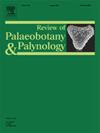An 11,000-year vegetation and climate record from a subalpine peatland in the Luoxiao Mountains, subtropical Southeast China
IF 1.7
3区 地球科学
Q2 PALEONTOLOGY
引用次数: 0
Abstract
The evolution of broadleaved forests and their responses to climate changes in subtropical Southeast China remain largely unclear, partly because of the controversies regarding the history of climate (i.e., temperature and monsoonal precipitation) changes during the Holocene. In this study, we integrated pollen and other proxies (including loss on ignition, humification degree, and stable carbon isotope) from a subalpine peatland in the Luoxiao Mountains, to reveal the predominant patterns of vegetation and climate dynamics in mountainous Southeast China. Vegetation at the study site was dominated by Quercus-evergreen and Fagus with relatively flourishing herbs during the early Holocene. A transformation from mixed evergreen–deciduous broadleaved forests to evergreen broadleaved forests occurred between 8200 and 1850 cal. yr BP. The lag of the transformation in response to monsoonal rainfall changes in mountainous regions during the early Holocene can be attributed to thermal limitation. Since 1850 cal. yr BP, broadleaved pollen substantially declined with the expansion of Poaceae and pines, likely reflecting the impact of intensive anthropogenic activities. The expansion of evergreen broadleaved forests from different sites revealed a gradual warming in Southeast China during the Holocene. Additionally, monsoon precipitation in the study area underwent substantial changes, showing a pattern of wetting, sustained humid conditions, subsequent drying, and wetting. Overall, temperature and precipitation during the Holocene were decoupled at the study site, as supported by widely distributed records in mountainous subtropical Southeast China. This may be attributed to the influence of different driving factors on temperature and precipitation.
中国东南部亚热带罗霄山亚高山泥炭地11000年植被和气候记录
中国亚热带东南部阔叶林的演变及其对气候变化的响应在很大程度上是不清楚的,部分原因是对全新世气候(即温度和季风降水)变化的历史存在争议。通过对罗霄山亚高山泥炭地的花粉和其他指标(包括着火损失、腐殖化程度和稳定碳同位素)的综合分析,揭示了东南山区植被和气候动态的主要模式。全新世早期植被以常绿栎树和蕨类植物为主,草本植物相对丰富。8200 ~ 1850 cal. yr BP之间发生了常绿落叶混交林向常绿阔叶林的转变。全新世早期山区对季风降水变化响应的滞后可归因于热限制。自1850 cal. yr BP以来,阔叶花粉随着禾科和松科的扩张而大幅下降,可能反映了强烈的人类活动的影响。不同地点常绿阔叶林的扩张揭示了全新世以来中国东南部气候逐渐变暖的趋势。此外,研究区的季风降水经历了实质性的变化,呈现出湿润、持续湿润、随后干燥和湿润的模式。总体而言,全新世温度与降水在研究点呈解耦关系,华南副热带山区分布广泛。这可能与不同驱动因素对温度和降水的影响有关。
本文章由计算机程序翻译,如有差异,请以英文原文为准。
求助全文
约1分钟内获得全文
求助全文
来源期刊
CiteScore
3.50
自引率
21.10%
发文量
149
审稿时长
6 months
期刊介绍:
The Review of Palaeobotany and Palynology is an international journal for articles in all fields of palaeobotany and palynology dealing with all groups, ranging from marine palynomorphs to higher land plants. Original contributions and comprehensive review papers should appeal to an international audience. Typical topics include but are not restricted to systematics, evolution, palaeobiology, palaeoecology, biostratigraphy, biochronology, palaeoclimatology, paleogeography, taphonomy, palaeoenvironmental reconstructions, vegetation history, and practical applications of palaeobotany and palynology, e.g. in coal and petroleum geology and archaeology. The journal especially encourages the publication of articles in which palaeobotany and palynology are applied for solving fundamental geological and biological problems as well as innovative and interdisciplinary approaches.

 求助内容:
求助内容: 应助结果提醒方式:
应助结果提醒方式:


